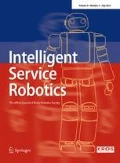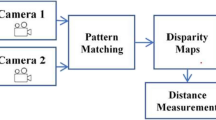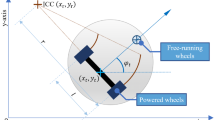Abstract
Recently, stereovision has appeared in robotics as a source of information for real-time mapping and path planning. In this paper, an intelligent motion system for mobile robots is designed and implemented using stereovision. The proposed system uses stereovision as a primary method for sensing the environment, and the system is able to navigate intelligently in an indoor environment with varying degrees of obstacle complexity. It creates noiseless and high-confidence 3D point clouds and uses these point clouds as an input for the mapping and path-planning modules. The proposed system was built by developing, enhancing, and integrating various techniques, modules and algorithms. The Stereovision-based Path-planning module is the integration of three main enhanced techniques: (1) the multi-baseline multi-view stereovision filter (MMSVF), (2) accurate floor detection and segmentation (AFDS), and (3) the intelligent gazing module (IGM). This Stereovision-based Path planning (MMSVF, IGM, and AFDS) was integrated with the Fuzzy Logic Motion Controller (FLMC). All techniques, modules and algorithms are implemented using a multi-threaded and client–server-based architecture. To prove the viability and robustness of our proposed system, we have integrated all components of the system into a fully functional mobile robot navigation system. We compared the performance of the main modules with that of similar modules in the literatures, and showed that our modules had better performance. Testing the whole system is more important than just testing each module individually. To the best of our knowledge, the literatures lack such testing. Hence, in this paper we present the performance of our complete integrated system in different environments using different parameters and different architectures.











Similar content being viewed by others
References
Lategahn H, Derendarz W, Graf T, Kitt B, Effertz J (2010) Occupancy grid computation from dense stereo and sparse structure and motion points for automotive applications. In: Intelligent vehicles symposium (IV), 2010 IEEE, pp 819–824
Shi C, Wang G, Yin X, Pei X, He B, Lin X (2012) High-accuracy stereo matching based on adaptive ground control points. Image Processing, IEEE Transactions on 24(4):1412–1423
Mei X, Sun X, Zhou M, Jiao S, Wang H, Zhang X (2011) On building an accurate stereo matching system on graphics hardware. In: IEEE international conference on computer vision workshops (ICCV Workshops), pp 467–474
Ambrosch K, Kubinger W (2010) Accurate hardware-based stereo vision. Comput Vis Image Underst 114(11):1303–1316
Lemaire T, Berger C, Jung I-K, Lacroix S (2007) Vision-based slam: stereo and monocular approaches. Int J Comput Vis 74(3):343–364
Rusu RB, Blodow N, Beetz M (2009) Fast point feature histograms (FPFH) for 3D registration. In: IEEE international conference on robotics and automation, 2009. ICRA’09, pp 3212–3217
Steder B, Rusu RB, Konolige K, Burgard W (2011) Point feature extraction on 3D range scans taking into account object boundaries. In: IEEE international conference on robotics and automation (ICRA), pp 2601–2608
Johnson AE, Hebert M (1999) Using spin images for efficient object recognition in cluttered 3D scenes. IEEE Trans Pattern Anal Mach Intell 21(5):433–449
Stiene S, Lingemann K, Nuchter A, Hertzberg J (2006) Contour-based object detection in range images. In: Third international symposium on 3D data processing, visualization, and transmission, IEEE, pp 168–175
Ledwich L, Williams S (2004) Reduced SIFT features for image retrieval and indoor localisation. In: Australian conference on robotics and automation, 2004. Citeseer
Schleicher D, Bergasa LM, Barea R, Lopez E, Ocaa M, Nuevo J, Fernandez P (2007) Real-time stereo visual slam in large-scale environments based on sift fingerprints. In: IEEE international symposium on intelligent signal processing, 2007. WISP 2007, pp 1–6
Sinha U (2010) Sift: scale invariant feature transform. AI Shack 14, Harvard
Bais A, Sablatnig R, Gu J, Khawaja YM, Usman M, Hasan GM, Iqbal MT (2008) Stereo vision based self-localization of autonomous mobile robots. In: Sommer G, Klette R (eds) Robot Vision. Springer, Berlin, pp 367–380
Ghayalod MP, Hall EL (1992) Intelligent robot control using omnidirectional vision. In: Applications in optical science and engineering, 1992. International society for optics and photonics, pp 573–584
Inaba M, Kanehiro F, Kagami S, Inoue H (1995) Vision-equipped apelike robot based on the remote-brained approach. In: 1995 IEEE international conference on robotics and automation. 1995. Proceedings, pp 2193–2198
Matthies L, Shafer S (1987) Error modeling in stereo navigation. J IEEE Robot Autom 3(3):239–248
Fazl-Ersi E, Tsotsos JK (2009) Region classification for robust floor detection in indoor environments. In: Kamel M, Campilho A (eds) Image analysis and recognition. Springer, Berlin, pp 717–726
Murray D, Jennings C (1997) Stereo vision based mapping and navigation for mobile robots. In: 1997 IEEE international conference on robotics and automation. Proceedings 1997, pp 1694–1699
Elfes A (1989) Using occupancy grids for mobile robot perception and navigation. Computer 22(6):46–57
Kuhn A, Hirschmüller H, Mayer H (2013) Multi-resolution range data fusion for multi-view stereo reconstruction. In: Weickert J, Hein M, Schiele B (eds) Pattern Recognition. Springer, Berlin, pp 41–50
Milella A, Reina G, Foglia MM (2013) A multi-baseline stereo system for scene segmentation in natural environments. In: 2013 IEEE international conference on technologies for practical robot applications (TePRA), pp 1–6
Gallup D, Frahm J-M, Mordohai P, Pollefeys M (2008) Variable baseline/resolution stereo. In: IEEE conference on computer vision and pattern recognition, 2008. CVPR 2008, pp 1–8
Wang H, Xu J, Guzman JI, Jarvis RA, Goh T, Chan CW (2001) Real time obstacle detection for AGV navigation using multi-baseline stereo. In: Rus D, Singh S (eds) Experimental robotics VII. Springer, Berlin, pp 561–568
Pahlavan K, Eklundh J-O (1992) A head-eye system-analysis and design. CVGIP Image Underst 56(1):41–56
Samson E, Laurendeau D, Parizeau M, Comtois S, Allan J-F, Gosselin C (2006) The agile stereo pair for active vision. Mach Vis Appl 17(1):32–50
Cindy X, Collange F, Jurie F, Martinet P (2001) Object tracking with a pan-tilt-zoom camera: application to car driving assistance. In: IEEE International Conference on Robotics and automation. Proceedings 2001, ICRA, 2001 IEEE, pp 1653-1658
Milios E, Jenkin M (1993) Torsional eye movements. In: IEEE International Conference on Act Robot Vis Camera Heads Model Based Navig React Control, vol 6, p 51
Nakagawa M, Adachi E, Takase R, Okamura Y, Kawai Y, Yoshimi T, Tomita F (2008) Gaze tracking control using an active stereo camera. Int Arch Photogramm Remote Sens Spat Inf Sci 37(Part B3b):387–392
Kühnlenz K, Lidoris G, Wollherr D, Buss M (2007) On foveated gaze control and combined gaze and locomotion planning. INTECH Open Access Publisher
Stachniss C, Grisetti G, Burgard W (2005) Information gain-based exploration using rao-blackwellized particle filters. In: Robotics science and systems, vol 2, pp 65–72
Bourgault F, Makarenko AA, Williams SB, Grocholsky B, Durrant-Whyte HF (2002) Information based adaptive robotic exploration. In: IEEE/RSJ international conference on intelligent robots and systems, pp 540–545
Rashid R, Elamvazuthi I, Begam M, Arrofiq M (2010) Differential drive wheeled mobile robot (WMR) control using fuzzy logic techniques. In: 2010 Fourth Asia International Conference on mathematical/analytical modelling and computer simulation (AMS), pp 51–55
Faisal M, Hedjar R, Al Sulaiman M, Al-Mutib K (2013) Fuzzy logic navigation and obstacle avoidance by a mobile robot in an unknown dynamic environment. Int J Adv Robot Syst 10
Raudonis V, Maskeliunas R (2011) Trajectory based fuzzy controller for indoor navigation. In: 2011 IEEE 12th International Symposium on computational Intelligence and Informatics (CINTI), pp 69–72
Li T-H, Chang S-J, Tong W (2004) Fuzzy target tracking control of autonomous mobile robots by using infrared sensors. IEEE Trans Fuzzy Syst 12(4):491–501
Narvydas G, Simutis R, Raudonis V (2007) Autonomous mobile robot control using fuzzy logic and genetic algorithm. In: 4th IEEE Workshop on intelligent data acquisition and advanced computing systems: technology and applications, 2007. IDAACS 2007, pp 460–464
Cupertino F, Giordano V, Naso D, Delfine L (2006) Fuzzy control of a mobile robot. IEEE Robot Autom Mag 13(4):74–81
Fua P (1991) Combining stereo and monocular information to compute dense depth maps that preserve depth discontinuities. In: International joint conference on artificial intelligence (IJCAI)
Murray D, Little JJ (2000) Using real-time stereo vision for mobile robot navigation. Auton Robot 8(2):161–171
Głąbowski M, Musznicki B, Nowak P, Zwierzykowski P (2012) Shortest path problem solving based on ant colony optimization metaheuristic. Image Process Commun 17(1–2):7–17
Thrun S, Burgard W, Fox D (2005) Probabilistic robotics, vol 1. MIT press, Cambridge
Khalid Almutib ME, Mansour Alsulaiman, Hedjar Ramdane and Ebrahim Mattar (2014) Reliable multi-baseline stereovision filter for navigation in unknown indoor environments. In: Paper presented at the 29th international conference on computers and their applications (CATA), Las Vegas, Nevada, USA
Emaduddin M, AlMutib K, AlSulaiman M, Hedjar R, Mattar E (2012) Accurate floor detection and segmentation for indoor navigation using RGB+ D and stereo cameras. In: Proceedings of the 2010 international conference on image processing, computer vision, pattern recognition (2012)
Faisal M, A-M K, Hedjar R, Mathkour H, Alsulaiman M, Mattar E (2014) Behavior based mobile for mobile robots navigation and obstacle avoidance. Int J Comput Commun 8
Khalid Almutib ME, Mansour Alsulaiman, Hedjar Ramdane, Ebrahim Mattar (2014) Smart stereovision based gaze control for navigation in low-feature unknown indoor environments. In: 5th intelligent systems, modeling and simulation (ISMS), Langkawi, Malaysia
Yoon H-J, Hwang Y-C, Cha E-Y (2010) Real-time container position estimation method using stereo vision for container auto-landing system. In: 2010 International conference on control automation and systems (ICCAS), pp 872–876
Murarka A, Kuipers B (2009) A stereo vision based mapping algorithm for detecting inclines, drop-offs, and obstacles for safe local navigation. In: IEEE/RSJ international conference on intelligent robots and systems, 2009. IROS 2009, pp 1646–1653
Sturm J, Magnenat S, Engelhard N, Pomerleau F, Colas F, Burgard W, Cremers D, Siegwart R (2011) Towards a benchmark for RGB-D SLAM evaluation. In: Proceedings of the RGB-D workshop on advanced reasoning with depth cameras at robotics: science and systems conference (RSS), Los Angeles, USA, p 3
Acknowledgments
The authors extend their appreciation to the Deanship of Scientific Research at King Saud University for funding this work through Research Group No. RG-1437-018.
Author information
Authors and Affiliations
Corresponding author
Rights and permissions
About this article
Cite this article
Al-Muteb, K., Faisal, M., Emaduddin, M. et al. An autonomous stereovision-based navigation system (ASNS) for mobile robots. Intel Serv Robotics 9, 187–205 (2016). https://doi.org/10.1007/s11370-016-0194-5
Received:
Accepted:
Published:
Issue Date:
DOI: https://doi.org/10.1007/s11370-016-0194-5




